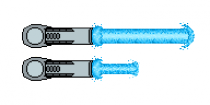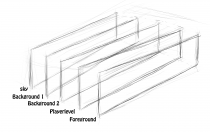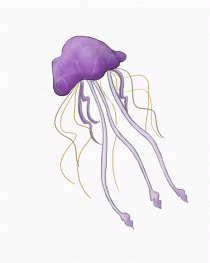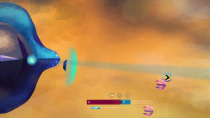Browsing 'Game Design': Posts from either of the Game Design programs

Insight #4 – Lasers & Animation
As explained in Insight #2 – Iteration, in our adaptation of the Behemoth game concept we decided on a military sci-fi setting with dystopian and cyberpunk elements through an arcade art style. Having this as our aesthetic cornerstone, we gravitated towards energy fields and lasers when we designed the visual representation of the ship’s dynamic elements; for example, we replaced the original explosive cannonball-like projectile with a powerful energy burst akin to that of an ‘energy attack’ as seen in […]

Insight #4 – Lasers & Animation
As explained in Insight #2 – Iteration, in our adaptation of the Behemoth game concept we decided on a military sci-fi setting with dystopian and cyberpunk elements through an arcade art style. Having this as our aesthetic cornerstone, we gravitated towards energy fields and lasers when we designed the visual representation of the ship’s dynamic elements; for example, we replaced the original explosive cannonball-like projectile with a powerful energy burst akin to that of an ‘energy attack’ as seen in […]

The Mist of Umibozu
One of the defining visual features of Umibozu is the mist, so it was important to discover a way to create a visually compelling asset that would surround the player for majority of the gameplay.
Throughout the development of Umibozu, I have returned to the subject of animating the mist with unsatisfying results a couple of times up until this week.
There were a few requirements I set for the mist design before producing it:
Concealment: The mist acts as a layer of concealment […]

The Mist of Umibozu
One of the defining visual features of Umibozu is the mist, so it was important to discover a way to create a visually compelling asset that would surround the player for majority of the gameplay.
Throughout the development of Umibozu, I have returned to the subject of animating the mist with unsatisfying results a couple of times up until this week.
There were a few requirements I set for the mist design before producing it:
Concealment: The mist acts as a layer of concealment […]

Blog 4: Parallallallax
Hi!
In this entry I will write about the development of the background for our game Beelonging.
In our game you control a swarm of bees flying back to save the beehive from a hungry bear. It takes place in a forrest, so for our background we wanted to include trees, stones, bushes etc. Since our game is a side scroller, we wanted to have a parallax background, which means that you divide the background into several layers (background, player, foreground) and make them […]

Blog 4: Parallallallax
Hi!
In this entry I will write about the development of the background for our game Beelonging.
In our game you control a swarm of bees flying back to save the beehive from a hungry bear. It takes place in a forrest, so for our background we wanted to include trees, stones, bushes etc. Since our game is a side scroller, we wanted to have a parallax background, which means that you divide the background into several layers (background, player, foreground) and make them […]
Is it better to stay in the background at times?
As I was trying to come up with a topic for this weeks blog post I was thinking of situations in which the team would meet up to work. I try to make this a common practice within our team. For the most part I am always the one who schedules the work times and I also make sure that we have someplace to work, yet once we are there, I don’t really do anything special. We usually host the […]
Is it better to stay in the background at times?
As I was trying to come up with a topic for this weeks blog post I was thinking of situations in which the team would meet up to work. I try to make this a common practice within our team. For the most part I am always the one who schedules the work times and I also make sure that we have someplace to work, yet once we are there, I don’t really do anything special. We usually host the […]

Blog Post 4 – Level design
Level design is one of the things many people greatly underestimate. Great level design often goes under the radar since most of the time you don’t notice when its good, you only notice when its bad. Creating a level that would do our game justice was my main focus this week.
We are creating a game from the umibozu concept document and our game has a big focus on exploration. When exploration is a big part of the game, the level […]

Blog Post 4 – Level design
Level design is one of the things many people greatly underestimate. Great level design often goes under the radar since most of the time you don’t notice when its good, you only notice when its bad. Creating a level that would do our game justice was my main focus this week.
We are creating a game from the umibozu concept document and our game has a big focus on exploration. When exploration is a big part of the game, the level […]

Missing minor in digital audio design
Developing a digital game in a group of five game design students in four minors – game design, programming, graphics, and project manager, some may note that one minor is necessarily missing. In a cross-functional small team developing a game, optimally anyone can take a part as a sound designer, and contribute to the project in a best way as he or she can, although quality may vary, based on previous experience, skills, musical nature and nurture. Some student groups […]

Missing minor in digital audio design
Developing a digital game in a group of five game design students in four minors – game design, programming, graphics, and project manager, some may note that one minor is necessarily missing. In a cross-functional small team developing a game, optimally anyone can take a part as a sound designer, and contribute to the project in a best way as he or she can, although quality may vary, based on previous experience, skills, musical nature and nurture. Some student groups […]
Simple AI
Today, I am going to be talking about Artificial Intelligence (AI) in its most simple terms. AI is the intelligence that is placed on Non-Player Characters or NPC’s. NPC’s for example, are the enemies or villagers within a game. As a programmer that is relatively new to Game programming it can be hard to implement… Continue reading Simple AI
Simple AI
Today, I am going to be talking about Artificial Intelligence (AI) in its most simple terms. AI is the intelligence that is placed on Non-Player Characters or NPC’s. NPC’s for example, are the enemies or villagers within a game. As a programmer that is relatively new to Game programming it can be hard to implement… Continue reading Simple AI

Add a new enemy type: shooting enemy
Before the beta playtesting, I was working on adding a new enemy which can shoot at the player in our game. Before that, there were only two kinds of enemies in our game: glaucus and pufferfish, and they all behaved in a similar way. In the game they will only move to the player, not firing projectiles, which is a bit boring in a shoot’em up game.
Then our group decided to add a new enemy to our game: Sky ray. […]

Add a new enemy type: shooting enemy
Before the beta playtesting, I was working on adding a new enemy which can shoot at the player in our game. Before that, there were only two kinds of enemies in our game: glaucus and pufferfish, and they all behaved in a similar way. In the game they will only move to the player, not firing projectiles, which is a bit boring in a shoot’em up game.
Then our group decided to add a new enemy to our game: Sky ray. […]

Jellyfish on the Move
This week I would like to talk about the design and animation process of our second enemy, the jellyfish.
The enemy jellyfish has normal movement speed, low damage and has melee attack. It also latches onto the player avatar and slows it. I liked the idea of a jellyfish gliding in the sky because of its natural movement pattern. And thought the leg and tentacle movement would look aesthetic.
I started the design process by looking up several jellyfish types, and came […]

Jellyfish on the Move
This week I would like to talk about the design and animation process of our second enemy, the jellyfish.
The enemy jellyfish has normal movement speed, low damage and has melee attack. It also latches onto the player avatar and slows it. I liked the idea of a jellyfish gliding in the sky because of its natural movement pattern. And thought the leg and tentacle movement would look aesthetic.
I started the design process by looking up several jellyfish types, and came […]

Game Design 2: Blogpost #4, Balancing and level-design
During the making of our game Behemoth, we found it important that we wanted the game to feel challenging but also fair. A lot of time was spent tweaking the difficulty in accordance to different people’s input about the game (you can read more about this in blog #5).
The tutorial of the game is set up to introduce the player to all the main mechanics that they will need to use in the later levels.
The first two levels of the […]

Game Design 2: Blogpost #4, Balancing and level-design
During the making of our game Behemoth, we found it important that we wanted the game to feel challenging but also fair. A lot of time was spent tweaking the difficulty in accordance to different people’s input about the game (you can read more about this in blog #5).
The tutorial of the game is set up to introduce the player to all the main mechanics that they will need to use in the later levels.
The first two levels of the […]
Comment #3: Carl Leong
https://carlgraphicscourse.wordpress.com/2018/02/22/the-scrumptious-parts-of-scrum/
Hi Carl!
Overall I liked your blog post describing the way the SCRUM method works for you and I generally share the same feelings regarding this subject. However, when referring to how the development method is based upon previous cycles I find it quite hard understanding the issue of not being able to work on specific goals until the sprint is completed. From my point of view the whole basis of Agile planning is to revisit some of the items, […]
Comment #3: Carl Leong
https://carlgraphicscourse.wordpress.com/2018/02/22/the-scrumptious-parts-of-scrum/
Hi Carl!
Overall I liked your blog post describing the way the SCRUM method works for you and I generally share the same feelings regarding this subject. However, when referring to how the development method is based upon previous cycles I find it quite hard understanding the issue of not being able to work on specific goals until the sprint is completed. From my point of view the whole basis of Agile planning is to revisit some of the items, […]
Comment #2: Alexander Sinn
https://shirovfx.wordpress.com/2018/02/15/creating-an-unfogettable-ambient/
Hallo!
This blog entry is very cool! The way you describe what you are doing is both a narrative and a technical description, which is very pleasant and enjoyable to read. You describe very nicely each step that leads to the final decision and seeing that you are not really content with the result (even though the fog looks pretty damn nice and it expresses a lot of feeling), but you are eager to improve in the future […]
Comment #2: Alexander Sinn
https://shirovfx.wordpress.com/2018/02/15/creating-an-unfogettable-ambient/
Hallo!
This blog entry is very cool! The way you describe what you are doing is both a narrative and a technical description, which is very pleasant and enjoyable to read. You describe very nicely each step that leads to the final decision and seeing that you are not really content with the result (even though the fog looks pretty damn nice and it expresses a lot of feeling), but you are eager to improve in the future […]